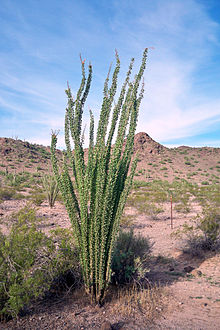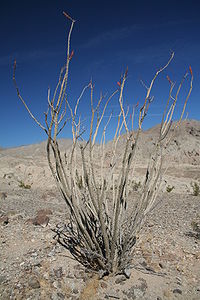- Fouquieria splendens
-
"Ocotillo" redirects here. For the census-designated place, see Ocotillo, California.
Fouquieria splendens 
Ocotillo during the monsoon season near Gila Bend, Arizona Scientific classification Kingdom: Plantae (unranked): Angiosperms (unranked): Eudicots (unranked): Asterids Order: Ericales Family: Fouquieriaceae Genus: Fouquieria Species: F. splendens Binomial name Fouquieria splendens
Engelm.Fouquieria splendens Engelm. is a desert plant of the southwestern United States and northern Mexico. Common names include ocotillo, desert coral, coachwhip, Jacob's staff, and vine cactus, although it is not a true cactus. For much of the year, the plant appears to be an arrangement of large spiny dead sticks, although closer examination reveals that the stems are partly green. With rainfall the plant quickly becomes lush with small (2-4 cm) ovate leaves, which may remain for weeks or even months.
Individual stems may reach a diameter of 5 cm at the base, and the plant may grow to a height of 10 m. The plant branches very heavily at its base, but above that the branches are pole-like and only infrequently divide further, and specimens in cultivation may not exhibit any secondary branches. The leaf stalks harden into blunt spines, and new leaves sprout from the base of the spine.
The bright crimson flowers appear especially after rainfall in spring, summer, and occasionally fall. Flowers are clustered indeterminantly at the tips of each mature stem. Individual flowers are mildly zygomorphic and are pollinated by hummingbirds and native carpenter bees.
Contents
Cultivation
Ocotillos near Palm Springs, California.
Planting ocotillo can be done the year around with care. Ideal ocotillo plants have been grown from stem cuttings or from seed. Transplanting large bare-root plants has marginal success. They should be planted to the original growing depth and, as with cacti, in their original directional orientation. The original south side of the plant, which has become more heat and sunlight-resistant, should again face the brighter, hotter southern direction. If their direction is not marked, success is again limited.
Ocotillo plants prefer well drained sandy or gravely loam soils with light to moderate amounts of organic content. For caliche subsoil, break a hole through it so the plant has adequate drainage.
Sunny, open, unrestricted locations and those where surface water does not collect are ideal for ocotillo.
To help prevent a newly transplanted ocotillo from falling over or blowing down in a storm, large stones may be placed over the root area instead of staking, which often scars the stems. Leave two to four inches space around the trunk. Some degree of growth set-back is to be expected. Properly transplanted, however, this native plant will reestablish itself fairly quickly.
Transplanted ocotillo plants require irrigation to become established, but once established, they can survive on 8 inches of rainfall per year.
A well-balanced fertilizer at half strength will help ocotillo to grow faster. This will usually stimulate plant growth and vigor. However, do not apply fertilizer to newly transplanted plants. When using any fertilizer, apply it evenly to the soil surface over the rooting area and water well into the soil. Do not risk overfertilizing; this plant is adapted to harsh conditions without added fertilizer.
State plant protection laws are enforced; contact the state Department of Agriculture for specific regulations, restrictions, permits, penalties, etc. before digging and moving any cacti, agaves, ocotillos, yuccas, or other protected species. Purchased plants should be from a reputable source.
Uses
- Individual ocotillo stems are used as poles as a fencing material in their native region, and often take root to form a living fence.
- Owing to light weight and an interesting pattern, these have been used for canes or walking sticks.
- Flowers are collected, dried, and used for herbal tea.
- Fresh flowers are used in salads and have a tangy flavor.
Species
Three subspecies are accepted by some botanists:
- Fouquieria splendens subsp. splendens Engelm.
- Fouquieria splendens subsp. breviflora Hendrickson
- Fouquieria splendens subsp. campanulata (Nash) Henrickson
References
- C.Michael Hogan ed. 2010. Fouquieria splendens. Encyclopedia of Life
- Jepson Flora Project: Fouquiera splendens
- Calphotos: Fouquiera splendens
- Ocotillo (Fouquieria splendens) in Joshua Tree National Park
-
Closeup of ocotillo thorns in Anza-Borrego Desert State Park
-
Closeup of ocotillo flowers in Anza-Borrego Desert State Park
-
Ocotillo covered with rare snow in Tucson
-
Ocotillo with leaves outside Tucson Mountains after a North American monsoon rain.
See also
Categories:- Ericales
- Flora of the Sonoran Deserts
- North American desert flora
- Flora of the California desert regions
- Flora of New Mexico
- Flora of Texas
- Flora of Arizona
- Flora of Nevada
- Flora of Baja California
- Flora of Chihuahua
- Flora of Coahuila
- Flora of Durango
- Flora of Sonora
- Flora of Tamaulipas
- Flora of Zacatecas
- Flora of Guerrero
- Flora of Hidalgo
Wikimedia Foundation. 2010.









